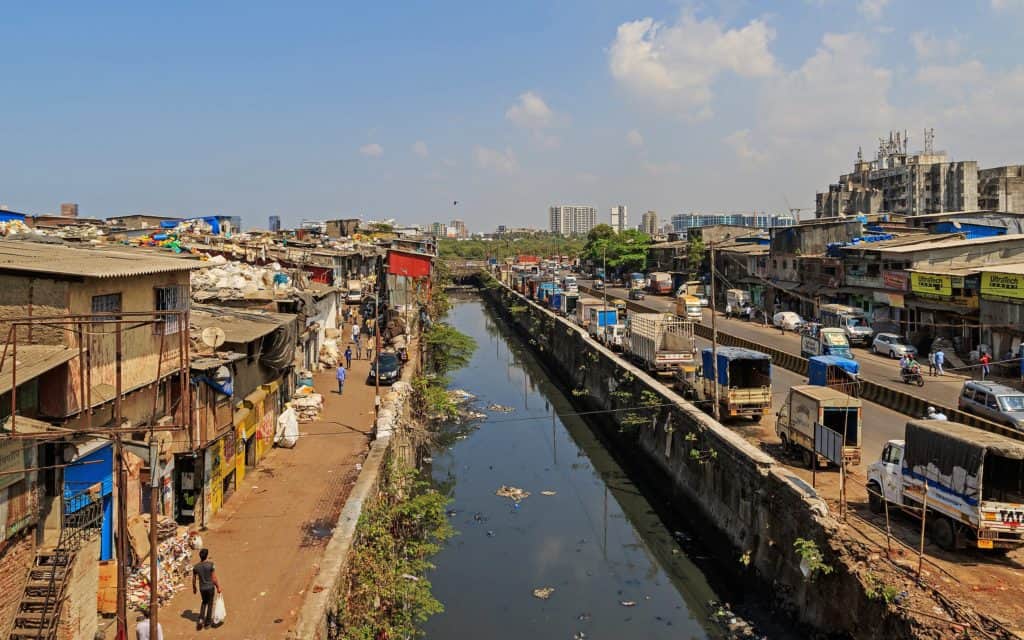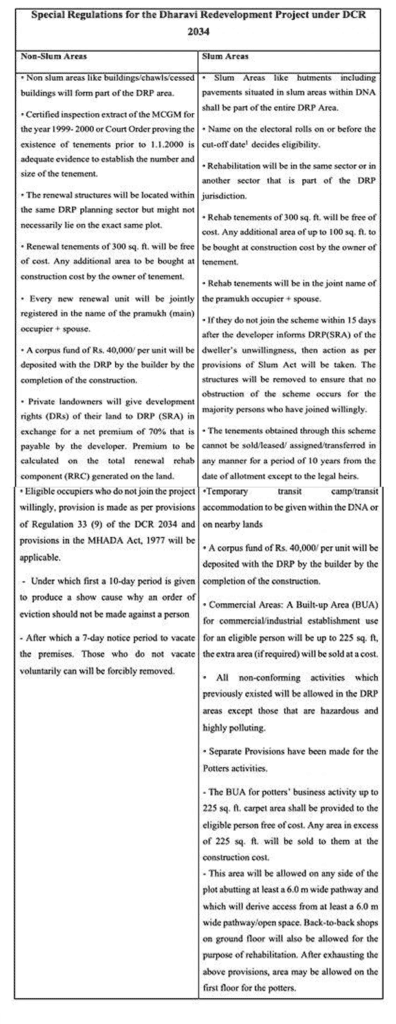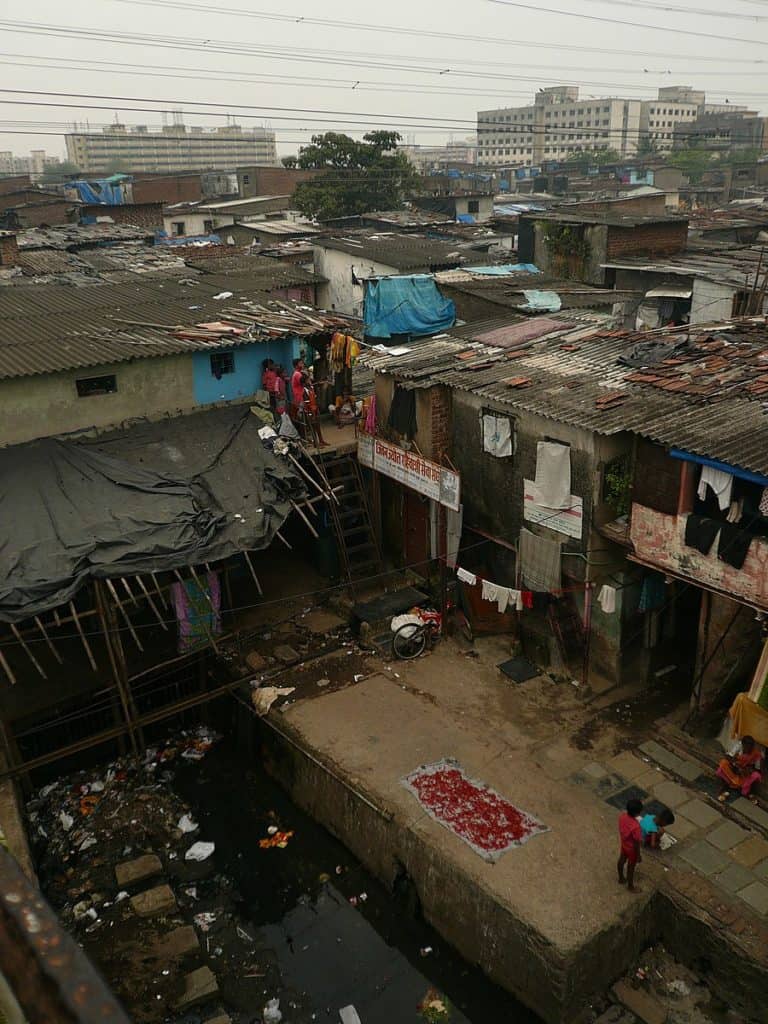
When you walk the streets of Dharavi today, it’s hard to imagine that its crooked but solid houses, informal but sophisticated business networks and heterogenous but distinct culture have been built over the remnants of a Koli fishing village. At the end of the nineteenth century, when industries like leather, waste-recycling, etc. were deemed too hazardous for colonial South Bombay, the peri-urban, swamp land which was home to the Koli fishing community became the saving grace for the displaced industries. And with that, Dharavi’s transformation into a mammoth industrial and residential settlement had begun.
Both the work and the workers settled onto the peri-urban marsh land on the northern frontier of the then main island city of Bombay. Slowly, the land grew firmer and the alleyways between settlements became narrower. Today, with the Mumbai Metropolitan Region expanding further into mainland Maharashtra, Dharavi has homogeneously been categorised as a centrally located ‘slum’ settlement that consistently and innovatively assimilates new and old migrant generations into its vibrant culture and lucrative informal economy.
In the eyes of the state Dharavi remains an eyesore on the path to ultimate urbanity. In the eyes of a concerned outsider, Dharavi serves as a constant reminder of the state’s inability and unwillingness to improve and upgrade basic housing and public infrastructure or develop inclusive models of urban development. The Dharavi Redevelopment Project (DRP) is essentially a product of these perspectives on some very native concerns.
Tracking the DRP
The NRI architect Mukesh Mehta envisioned the Dharavi Redevelopment Project (DRP) in 1995. In 2004, the Government of Maharashtra sanctioned the DRP. As it stands today, the DRP is set to revamp the Dharavi Notified Area (DNA), a roughly triangular patch of land covering a whopping 525 acres of prime land. But the last 16 years have seen the pace of the DRP pick-up and weaken several times.
After the DRP was officially sanctioned in 2004, the Dharavi Notified Area was created vide the 2005 Urban Development Department Resolution wherein the Slum Rehabilitation Authority (SRA) was appointed the Special Planning Authority for the DRP. The first round of global bids for the DRP were opened in 2007. 2007–08 also saw the Government and NGO MASHAL take on the mammoth task of conducting a GIS-biometric survey and a socio-economic baseline of sector 1–5 of Dharavi. But since the get-go, the DRP has failed to attract powerful builders and large investments given the precarity of the DRP and the volatility of the real-estate market. The government’s motivation to participate in the DRP was possibly diminished owing to the lack of private interest in the project. The period between 2008–2016 was a period of lull for the DRP, with the government run MHADA taking on the task of developing Dharavi sector 5.
This changed when the BJP lead government chose to further incentivise the DRP by setting up a special purpose vehicle (SPV) in 2018. Sectors 1–5 would be developed as one single entity by one single builder or consortium of builders. The state would have a 20 per cent (Rs. 100 crores) stake and the private developer would have an 80 per cent (Rs. 400 crores) stake in the SPV. In November 2018, the BMC sanctioned the Development Control Regulations 2034 with special regulations for the DRP.
In spite of the Government of Maharashtra’s initiative, even the most recent round of bidding attracted only two consortiums of builders — SecLink Technologies Corporation and Adani Infrastructure. SecLink Technologies Corporation (STC), the Dubai based consortium emerged the winner, guaranteeing an investment of Rs. 7,200 crores in the first phase of the project. But yet again, the project has entered a period of lull. STC is awaiting the Letter of Award from Government of Maharashtra (GoM) since early 2019 and is now threatening to sue the GoM . The GoM on its part is debating whether to scrap the 2018 bids altogether and float a new global tender.
As the timeline suggests, several private and government agencies, city and state departments, organisations, etc. that comprise the varies actors of the DRP, make the DRP implementation a complex maze to navigate, especially for the resident of Dharavi who remains a notably absent but conspicuous stakeholder in the long-drawn timeline of the project.

Photo: A.Savin (Wikimedia Commons)
Project Promises
Most literature has assumed an overwhelming opposition to the development from the residents and has failed to consider the up-side of (re)development for the residents of Dharavi. Even with the government dangling the DRP carrot over the residents’ heads for 16 years, there exists a dearth of public information about the official guarantees of the project and more importantly, the data that is available is dated and often difficult to access, online and in person. As the DRP sectors have been redrawn, bids have been opened and scrapped, and different land use plans have been sanctioned (most recent being 2016), the government appears to have struggled with information dissemination.
The most recent government document that defines the official promises, eligibility criteria, guarantees rehabilitation units and stipulates rules of construction for the DRP are the Development Control Regulations (DCR) 2034. As per the DCR, the DRP will have an overall FSI of 4.00 and all the slum areas and non-slum areas falling within the Dharavi Notified Area (DNA) will be undertaken for rehabilitation and renewal by the Slum Rehabilitation Authority.
Regulation 33 (9) (A) is applicable to the non-slum area i.e. buildings/structures and cessed properties within the DNA and Regulation 33(10)(A) is applicable to slum areas, i.e., hutments, notified slums and pavements within the DNA.

People’s Needs and Aspirations
When the YUVA team interviewed keypersons in Dharavi in March 2020, it was observed that much of the available information on the DRP, is saturated and trickles down into the larger community through community keypersons. It is important to note that the community keypersons that YUVA met are representing the views of only a few of the many different types of stakeholders in Dharavi. The time-restrictions of the project also meant that rapport building and in-depth interviews with residents could not be conducted.
The interviews found that the need for ‘development’ in Dharavi was universally acknowledged. However, more often than not the type of ‘development’ that the DRP envisioned was a cause of concern for the residents of Dharavi. The different actors that were interviewed — slum owners, renters, non-slum residents, private land owners and the original inhabitants — understandably had different concerns with respect to the DRP.
- Slum residents (owners): Through an interview conducted with Raju Korde, President, Dharavi Redevelopment Committee (on 03.03.2020) he was clear that any redevelopment of slums, cannot be piece-meal and must involve holistic planning given that slums are located on various types of land (estate, railways, BMC etc)and redevelopment must include amenities and services as well. It cannot be redevelopment of one slum pocket at a time the way the SRA does. He also stated that it is for this reason that the MHADA should be involved in planning as a government entity with all the expertise required. The Dharavi Redevelopment Committee has been making their demands, a few include — for the project to be declared a vital public project so that no cut off dates apply to determine eligibility of a household, size of redevelopment residential tenements to be 405 sq ft or more (300 sq ft +fungible component), and that commercial units also get a fair deal with regard to space. He felt that the project lacked political will had multiple ideas on how this could be carried out in away that is beneficial to Dharavi’s residents.
- Slum residents (renters/tenants): The renters interviewed (focus group discussion with BMC and private chawl residents on 12/03/2020) stated that they often faced harassment at the hands of the chawl or hutment owners. They continue to live in unsanitary and congested conditions in Dharavi and for that reason they are in favour of the DRP. The DRP would bring formalisation and security to their housing arrangements.
- Private Landowners: Private landowners refuse redevelopment under a slum improvement project. During the interviews private land owners (interview with Mr. D. Ingle on 12/03/2020 and Mr. P. Chougule on 12/03/2020) stated that if the Slum Rehabilitation Authority declared their land as a “slum area”, they would have to give up their lands. If included in the DRP, the landowners are demanding adequate economic compensation and rehabilitation for the residents of their chawls. Alternatively, they are demanding the right to self-develop their land.
- Non-slum Residents: A member of the DRP Sector One Rahivasi Krutisangh, stated that residents of structures and buildings (non-slum) falling within the DNA initially opposed the DRP. Under the DRP, many non-slum residents would receive rehabilitation tenements which were much smaller in area than their current homes. In addition, they also stand to lose many of the amenities in their societies like parking spaces, community halls, gardens, etc. The residents are negotiating with the GoM and are demanding rehab tenements of 700 sq. ft. under the DRP. Alternatively, they are demanding the right to self-develop their land outside of the DRP scheme.
- Original Inhabitants: A prominent member of the Koliwada Gaothan Vistar Sewa Samiti, stated that the community’s demand is the proper demarcation of the Dharavi Koliwada area. As the original inhabitants, the community estimates it owns approximately 100 acres, with the community currently living on approx. 10–15 acres. The community expects the government to either transfer land to the community, offer financial compensation or make alternative land arrangements. He said that if the government is making provisions for slum dwellers on the basis of human rights, it should make provisions for the original inhabitants who identify as Kolis and derive their identity from their original familial occupation and land.

What next for Dharavi?
This research was wrapped up just prior to the declaration of the nation-wide lockdown in the wake of the COVID-19 pandemic. The high rate of transmission of COVID-19 coupled with inability to follow social distancing norms has once again propelled Dharavi’s cramped living arrangements into the limelight. For many this was unsurprising, Dharavi has a high transmission rate of TB.
Dharavi is still known across the world as Asia’s largest slum. Even though Dharavi has long since lost its top spot, it remains the focal point of global discussions surrounding the difficulties of distancing under conditions of poverty, informality and congested living.
It should not only be a cause of concern but a wake up call that social distancing is physically impossible on 250-odd hectares of land with a population of approximately 8,50,000 residents and where 10 or more people often stay in housing units measuring 250 sq. ft. Plus, it is not unknown that one toilet in Dharavi is shared by a thousand plus people or that migrant workers living on rent make up a bulk of the population in Dharavi.
(Re)development has to be imagined as an on-going and inclusive process that recognises the roles, needs, wants and aspirations of the community. Dharavi is not homogeneous. This research found that the DRP has not only been delayed due to the many political and administrative factors, but its delay is also linked to the way Dharavi—the geography, the economics and socio-cultural environment is continuously changing. As the project drags on, people’s requirements keep changing. And the requirement is now is to imagine and prepare for a post-COVID world.
The pandemic can be a point of departure to change the popular development narrative around ‘slum-redevelopment’ and reimagine planning norms around slum redevelopment. Merely shifting slum-like housing to ‘formal’ high density buildings is not a solution. The size of the tenements, the final densities, the mobility of the population, health, sanitation and safety infrastructure must be given top priorities in the planning and execution of the DRP. A plan that homogenises an entire area under the guise of formalising the informal would be short sighted. The current crisis shows that the suggested plan only further densifies the area with an FSI of 4. But does not ask essential questions – is this a liveable future? will this be suited to a post pandemic world?
A two-way flow of information about the DRP is crucial to its success. A review of the needs that have made stark during the pandemic must be dovetailed to people’s needs through community involvement. Only then can any ‘redevelopment’ be a positive change that improves the quality of life of generations who will live in Dharavi.
This article was first published on the YUVA blog https://medium.com/@yuvaonline on 13 July 2020.